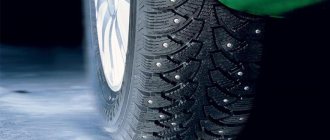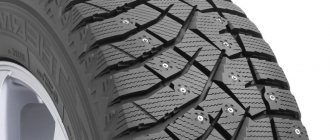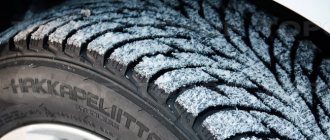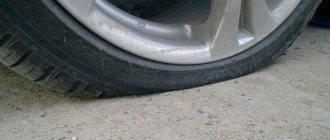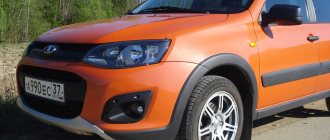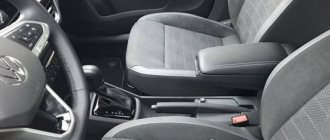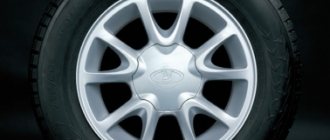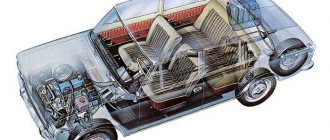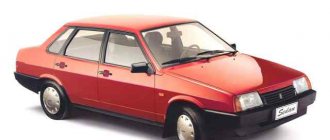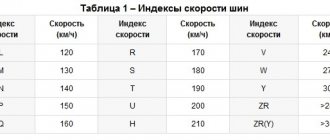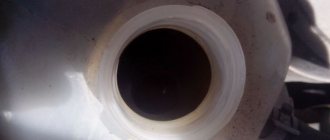Experts who conducted the tests
Before the start of the 2018-2019 winter season, the 185 65 r15 winter tires were tested by the following automotive publishing houses and expert communities:
- magazine "Autoreview" (Russia);
- magazine "Behind the wheel" (Russia);
- automobile portal "Autocenter" (Ukraine);
- technical supervision society GTÜ (Germany);
- Automobile Club of Europe ACE;
- automobile club ARBÖ (Austria).
Nokian winter tires All of the listed communities are authoritative experts whose opinions have a significant impact on the choice of motorists around the world.
Pit at zero
We evaluate controllability on a closed circuit configuration. This is a “track” about a kilometer long with turns of different radii and a long straight. And most importantly, the ice here is very slippery, polished by the wind. We carry out the assessment together, we drive three laps each on each set of tires, then we change.
Crap! Incredibly slippery! To change places, I had to literally crawl from one side to the other without taking my hands off the car.
Nokian tires earned the highest score in this exercise: clear reactions and good steering information are complemented by a soft, predictable start to the car's slip and stable grip regardless of the degree of slippage.
The Rio, shod with Nordman and Nitto tires, performed slightly worse. In the first case, I liked the good balance of longitudinal and lateral grip, the clear moment of transition to sliding. The rating was slightly reduced due to slight delays in reactions. At Nitto, the car captivated us with its good handling even when sliding and its tight, “understandable” steering at large turning angles. However, there were minor complaints about the information content of the steering wheel at small angles - in the initial phase of turning. The tire industry calls this effect hole in zero.
The lowest scores were given to Gislaved, Goodyear and Formula. On these tires, the driver is forced to increase the steering angles, causing delays in reactions. In addition, Rio on Gislaved tires slides for a long time in a turn, and then the grip is sharply restored, which provokes a whip effect - a sharp skid in the opposite direction.
Goodyear did not like the imbalance of longitudinal and lateral grip: the car holds the turning arc much worse than it accelerates and brakes. On Formula tires, there is low steering input when cornering, which provokes twisting and subsequent skidding.
The ice circle is the most unpleasant exercise for the driver. You need to find the maximum speed on the verge of sliding, show the best time (it is recorded by VBOX) and confirm it. In this case, you have to drive in one direction, counterclockwise. With good grip, the body and head roll with a decent lateral force - you constantly strain all your muscles. You have to constantly look from the “road” to the instruments and back. After about fifty laps my head starts to spin.
The Continental and Nokian turned out to be faster than the others on the lap - 19.9 seconds per full revolution. Cordiant was just one tenth behind them (20.0 sec). The slowest tires are Kumho: the best achievement is 22.5 seconds.
How many laps did you have to do on each set to achieve the best results and repeat them? From ten to fifteen! The only tires that required more attention and skill were Goodyear: the car shod with them kept trying to skid, and I had to do 19 laps. And in total, taking into account repeated races on base tires, our Rio had to turn up more than two hundred revolutions!
Where did the tests take place?
Traditionally, winter tire tests are carried out in four categories:
- on ice;
- on snow;
- on dry and wet asphalt.
Tests in harsh winter conditions took place mainly at Finnish testing grounds. German professionals preferred the small town of Saariselkä, which is located 200 kilometers beyond the Arctic Circle. The temperature in this place in winter remains stable at -15°C and allows testing different models with dimensions 1 85 65 r15 under absolutely equal conditions.
The Autoreview publication chose the famous White Hell training ground in Lapland, and the Russian magazine Za Rulem tested winter studded tires 185 65 r15 in the northern part of Sweden, in the Norrbotten region on Pirelli tracks. The air temperature ranged from -1°C to -15°C.
Related link:
Review of tire tests in size 175/65 R14.
Continental ContiViking Contact 6 - a new development of the famous brand
German quality and advanced technology are an important aspect of high-quality car operation. Even if your car is not from Germany, you can give it certain qualities of the German level. Buy Continental ContiViking Contact 6 tires. This is a new generation of the famous and successful tire with the following important features:
- excellent operating options with an asymmetrical unusual tread;
- the rubber clings perfectly to any surface and holds the road better than its competitors;
- use of the best materials for the manufacture of tire tread and cord;
- unprecedented durability and optimal performance in different modes.
You can choose suitable tires for a long time among the offers of world brands, but still not find the best option. If you give preference to Continental tires, you will not have any operational problems. When choosing tires, pay special attention to the German Continental. This is often the best solution for your car.
Test participants
For testing, experts selected tires from the world's leading manufacturers. Russian-made tires were also present in the tests organized by the publications Autoreview and Za Rulem.
Let's consider the 8 most popular models that will participate in the comparative test of winter 2018-2022.
- Dunlop SP Winter Ice 02.
- GoodyearUltra Grip Ice Arctic.
- Continental Ice Contact 2.
- Nokian Hakkapeliitta 9.
- Michelin X-Ice North4.
- Hankook Winter I*cept IZ2.
- Nexen Win Guard Snow'G WH2.
Both winter non-studded tires 185 65 r15 and tires equipped with studs take part in the races. For comparison, models with a wheel diameter of 15 inches are taken, but the results can be considered relevant for R14 wheels, since they are almost identical.
Summarizing
The leadership of Michelin and Dunlop is beyond doubt; these tires are capable of providing comfort and confidence in any winter conditions. Of the tested models, special mention should be made of Sava and Roadstone, which not only have low performance, but simply pose a real threat to traffic safety. The rest of the test participants have clearly defined strengths and weaknesses. Based on this, they can be recommended for specific winter conditions.
The article was prepared for the site autotema.info.
Table of characteristics of tested models
| Features of the spikes | Rubber compound composition | Price* | ||
| Dunlop SP WinterIce 02 | directional V-shaped tread pattern wide grooves for water drainage hard middle part with triangular checkers | Has a rectangular core Enlarged spine base Specially designed seat for the tenon shape | 4D Nano Design Technology Dual-layer tread with soft top layer and stiffer base | 130 dollars |
| Goodyear Ultra Grip Ice Arctic | Tread pattern with wide, sharp-angled grooves Large number of sipes | Triangular design Carbide insert with sharp edges 22 rows of studs over the entire tread surface | The composition contains silicon polymer, which provides additional adhesion to wet surfaces. | 108 dollars |
| Continental Ice Contact 2 | Has an asymmetric tread To improve stability, there are special grooves on the side parts of the tread blocks The slats have a zigzag shape | Extra-light Cristall Dubb studs "ice pockets" around the spikes Crystalline form of thorns High Temperature Fastening | The composition contains a large amount of rapeseed oil, which gives the tires elasticity. Silicon dioxide improves traction. | 130 dollars |
| Nokian Hakkapeliitta 9 | Has a directional tread pattern with deep drainage grooves. Special aramid fibers protect the wheel sidewall from cuts. | Use of two types of studsEco S tud 9 technology allows the studs to gently contact the surface | Green Elasto Proof rubber compound is environmentally friendly | 133 dollars |
| Michelin X-Ice North4 | The central part of the tread has a directional pattern with sharp edges of the blocks. The side blocks are larger and rectangular, which increases cross-country ability. | Smart spike technology Conical studs reminiscent of rally models Fastening with thermoactive mixture Reduced top flange diameter from 6.5 to 5 mm Increased number of spikes (up to 250 pcs) | Improved rubber compound allows tires to remain flexible down to record temperatures of -65°C | 117 dollars |
| Hankook Winter I*cept IZ2 | Reinforced central rib Large number of 3D lamellas throughout the entire surface | Studless tires | Contains highly dispersed silica | 100 dollars |
| Nexen Win Guard Snow'G WH2 | Hard center rib Movable shoulder checkers Rounded side blocks increase maneuverability | Studless tires | The rubber contains nanosilica | 54 dollars |
Related link:
8 models of winter tires in size 195/65 R15.
*Prices are current as of November 27, 2018
On thin ice
The Rio showed the best acceleration, 6.5 seconds, on Continental tires, the second result was on Nokian: 6.8 seconds. No one doubted that tires with 185–186 studs would be ahead. However, Cordiant, Goodyear and Nordman, which each have 110 studs, are hot on their heels - these three show a result of 6.9 seconds. The longest acceleration is from Kumho: 9.7 seconds.
In braking, Nokian wins over the Continental by the slightest - 16.4 meters versus sixteen and a half, and the third result, 16.7 meters, is shown by Goodyear. Kumho was again the last: 23.7 meters.
Test results
The main indicators of winter tires 185 65 r15 can be assessed on a 5-point scale as follows:
| Control on asphalt | Snow control | Ice control | External noise | Resource | Price quality | |
| Dunlop SP Winter Ice 02 | 4 | 4 | 5 | 3 | 4 | 3 |
| Goodyear Ultra Grip Ice Arctic | 4 | 5 | 3 | 4 | 4 | 5 |
| Continental Ice Contact 2 | 4 | 5 | 5 | 4 | 5 | 5 |
| Nokian Hakkapeliitta 9 | 4 | 5 | 5 | 3 | 5 | 4 |
| Michelin X-Ice North4 | 4 | 5 | 4 | 5 | 4 | 5 |
| Hankook Winter I*cept IZ2 | 4 | 3 | 4 | 3 | 4 | 5 |
| Nexen Win Guard Snow'G WH2 | 3 | 3 | 3 | 4 | 4 | 4 |
Which budget winter tires to buy
The review presents many high-quality, proven models. But besides good handling and wear resistance, there are several factors that determine which is better.
There are main types of winter tires - studded and friction or Velcro. Briefly: the first ones are better for ice, but are noisier, the second ones are good for snow, clean asphalt and they are quieter. However, at present, many manufacturers, in an effort to abandon studs that spoil the road surface, are actively working on the composition of friction clutches, negating their disadvantages. Thus, the key factor here is road conditions and the need for comfort. According to experts, it is acceptable for the city to take non-studded tires, especially for measured driving on clean roads. For mixed types of roads, you can take studded tires.
Our editors included diverse models in the rating of inexpensive winter tires. According to their characteristics, they are able to cover almost all the needs of a modern car owner; you just need to decide on the most optimal option.
Drivers' reviews of winter tires 185 65 R15
In addition to the test results of winter studless tires 185 65 r15, the decision to buy this or that tire is influenced by reviews from the owners of this model.
| Positive | Negative | |
| Dunlop SP Winter Ice 02 | I've been riding DunlopWinter Ice r14 for three years now. I've only lost a couple of studs, but I'm driving quite harshly. The tires are very reliable and corner well in any weather. | Very noisy. After the break-in, I thought that the noise would decrease, but it seems that it has become even greater. But overall the tires are good, which is not surprising for such a price. |
| Goodyear Ultra Grip Ice Arctic | It doesn't dull in the cold. Very short braking distance. Compared to my previous Rosava tires, it’s simply amazing how docile the car is in icy conditions! Despite the fact that the winter was practically without snow, I did not lose a single thorn. | In 2 seasons I lost 20% of my spines. It skids a little on ice, but I think this is due to the fact that I only have Goodyear wheels on my drive wheels, and Kama 505 on the rear wheels, which are simpler. |
| Continental Ice Contact 2 | The VW Golf 6 is in its second season. I'm incredibly happy with these tires. Even with heavy ice, you can safely reach speeds of up to 160 km/h. The spikes are all in place. | The tires are, of course, good, but for that price you can buy almost the same ones for a third cheaper. I paid $150 per wheel and didn't see much effect. Honestly, tires are just tires. They make noise, like all spikes. |
| Nokian Hakkapeliitta 9 | These are the best winter tires out there. It is not for nothing that it constantly ranks high in various studded tire ratings. Despite the high cost, I bought myself 4 wheels for an all-wheel drive car. Passing characteristics and controllability are excellent! | The two problems with this carving are the high price and the large sound effect. In addition, spikes are prohibited in most European countries, so think twice before purchasing. |
| Michelin X-Ice North4 | Premium tires, what can I say. I went to X-IceNorth3 last winter and was very pleased. Problem-free in any weather I think the “four” will be no worse, I’m going to buy my wife a Renault. | I recently purchased the tires and have not had to drive in the snow yet. It behaves a little unstable on wet asphalt, but I hope that the running-in of the studs is not over yet. |
| Hankook Winter I*cept IZ2 | Personally, this tire suits me perfectly. During the winter that I drove it, I never skidded or got stuck in the snow. It drives great everywhere, despite the fact that there are no studs. | Tires are not for our roads. Doesn't hold holes at all! During the season of operation - minus 1 wheel. |
| NexenWinGuardSnow'G WH2 | It is well suited for the mild climate of southern Ukraine. Temperature changes and light snow are quite tough for her. And it costs much less than Michelin and Nokian. | On ice it skids, on asphalt the steering wheel is difficult to obey. They are on a Lada Granta. For that kind of money, it’s better to buy something from the Nordman series and not suffer. |
Related link:
Cordiant Snow Cross and Kama Euro 519: which is better?
Reviews of friction and studded tires 185 65 R 14 and R15 are taken from the following sources: infoshina.com.ua, shiny-diski.com.ua, www.drom.ru, market.yandex.ru.
How are the seats distributed?
Based on the test and reviews from owners, the places in the rating of winter tires 185 65 r15 were distributed as follows:
- Continental Ice Contact 2. They have balanced characteristics and a high level of comfort. Feel confident on any surface.
- Nokian Hakkapeliitta 9. They are distinguished by the highest cross-country ability and directional stability, regardless of weather conditions. They get second place due to the fairly high noise level and high price.
- Michelin X-Ice North 4. Slightly inferior to the first two places in all respects. Not always stable on ice and dry asphalt
- Goodyear Ultra Grip Ice Arctic. They demonstrate excellent performance on asphalt and snow, which cannot be said about braking and maneuvering during icy conditions. Well suited for urban environments, but are noisy.
- Dunlop SP Winter Ice 02. Handles well on icy surfaces. The rest of the indicators are average or lower.
- Hankook Winter I*cept IZ2. They are very sensitive to road irregularities and do not always handle well on ice and snow. They have low acceleration rates on slippery surfaces.
- Nexen Win Guard Snow'G WH2. They have poor handling results on ice and snow according to test drive results. On asphalt they demonstrate an average level. They are affordable.
| Video - Lada Vesta and Supertest of winter tires 185/65/R15 |
| Video - Rating of the best tires 185/65 R15 |
Tags
Winter tires R14 Winter tires R15
Bridgestone Blizzak WS70 - Japanese answer to European quality
Many buyers of car tires are convinced that high-quality tires cannot be purchased outside of Europe. Therefore, European brands received maximum sales in the market of different countries. But the Japanese brand Bridgestone has not come to terms with this state of affairs, offering on the market quite high-quality Blizzak WS70 tires with the following characteristics:
- excellent implementation of a complex tread pattern on modern equipment;
- successful technologies for obtaining maximum quality of travel in winter;
- the best characteristics for traveling on snow and ice, but for asphalt the characteristics are not optimal;
- the low price tag and the availability of most popular sizes complement the advantages of the tires.
Despite such a list of benefits of buying Japanese tires, not many buyers choose them. Important characteristics of rubber make it quite easy to obtain the necessary quality of car operation in winter, but Bridgestone was never able to offer perfection in this regard. A car with these tires will show outstanding performance on the track, as well as on snowy or icy roads. Want more information about choosing tires? Watch the following video:
Let's move on to snow procedures
Snow fell exactly the next day after all ice tests were completed. It is easier to prepare a track for assessing handling than a plateau for measuring longitudinal grip. Therefore, we start with more creative and interesting work.
At one bend the route lies on the side of a hill, so it has a short but rather steep ascent and descent. This is a “trick” of local tracks for assessing handling - most tire manufacturers use mainly flat tracks. Ascents and descents load and unload the suspension, changing the vertical forces acting on the wheels. It is especially interesting when the wheel is unloaded in a turn: the downforce decreases and the tire begins to slip.
Fresh snow fell on the cold ice and shifted as the car slid around the turns. The result was a mixed surface: sometimes snow, sometimes ice - a real Russian road!
Here, in terms of handling, I liked the Nokian tires more than others: very soft but confident cat-like habits, predictable behavior of the car. Rio on these tires does not require special skills or techniques from the driver - he simply turns. The maximum speed is limited by a soft skid that helps to register the turn, requiring virtually no adjustment.
The experts made the greatest claims against the next three participants. Cordiant is annoying with an unexpectedly occurring skid with a sharp, unpredictable stall, a long slide and the same sharp restoration of traction, which provokes a “shooting” skid in the opposite direction. On Gislaved tires, the steering wheel becomes unpleasantly empty and uninformative - you have to turn it at excessively large angles, which leads to an unexpected sharp slip into a skid and deep slides. I didn’t like the Kumho tires because of noticeable delays in reactions, significant steering angles, prolonged slides and deep skidding on an arc, requiring immediate adjustments from the driver.
